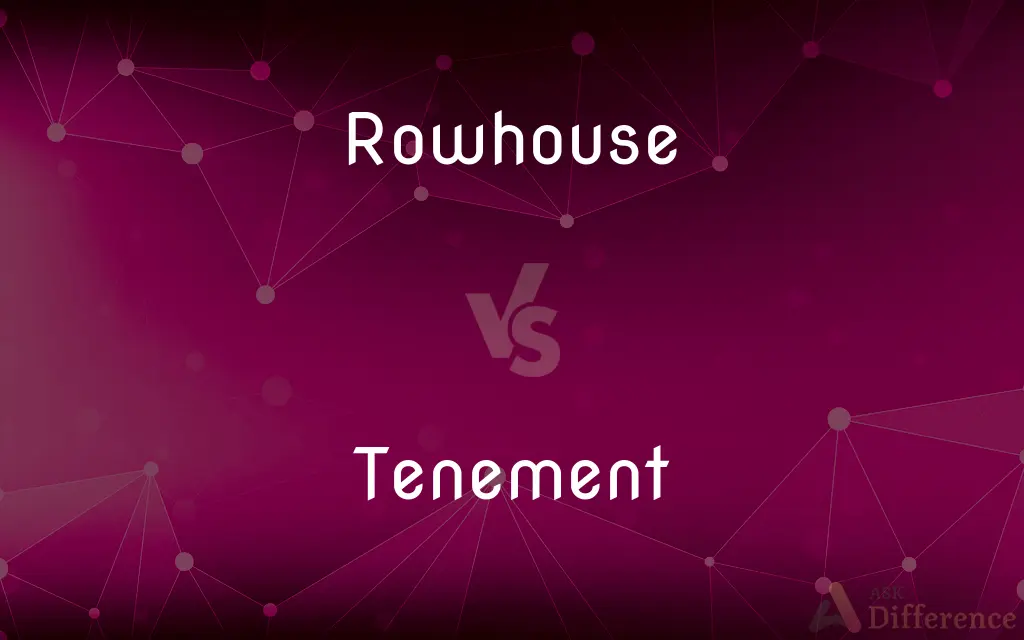Rowhouse vs. Tenement — What's the Difference?
By Maham Liaqat & Fiza Rafique — Updated on March 31, 2024
Rowhouses are individual homes sharing side walls, known for uniformity and private entrances; tenements are multi-family buildings, historically overcrowded and with minimal amenities.

Difference Between Rowhouse and Tenement
Table of Contents
ADVERTISEMENT
Key Differences
Rowhouses are typically found in a variety of urban settings, from historic districts to modern developments. They are prized for their efficient use of space and the ability to offer homeownership in densely populated areas. On the other hand, tenements, while not as prevalent today in their original form, have evolved into modern apartment buildings that seek to address past inadequacies by offering improved living conditions and amenities.
In terms of layout and amenities, rowhouses usually consist of two to four stories, with each unit having its own entrance and multiple floors of living space, promoting a sense of privacy and ownership. Tenements, historically, had a more basic layout, with several families often sharing single floors, communal toilets, and limited access to natural light and ventilation, which contributed to unhealthy living environments.
Ownership and rental patterns also differ significantly between the two. Rowhouses are typically owned by individuals or families, offering a sense of permanence and investment in the community. Tenements, traditionally rental properties, were owned by landlords who maximized space to accommodate as many tenants as possible, often leading to the exploitation of occupants.
Despite their differences, both rowhouses and tenements have played significant roles in the development of urban housing, reflecting the changing needs and challenges of city living. Today, efforts to preserve historic rowhouses and renovate tenement buildings into safe, affordable housing reflect an ongoing commitment to addressing urban housing needs.
Comparison Chart
Structure
Individual homes sharing side walls
Multi-family apartment buildings
ADVERTISEMENT
Historical Context
Varied, with examples from historic to modern
Associated with 19th and early 20th-century urban working-class housing
Amenities
Private entrances, sometimes yards or gardens
Historically minimal, often overcrowded
Ownership
Typically owned by individuals or families
Historically rental units, owned by landlords
Urban Impact
Offers homeownership in dense areas
Reflected challenges of urbanization and housing shortages
Compare with Definitions
Rowhouse
Offers a sense of individuality and privacy.
Despite being connected, each rowhouse had its unique interior design.
Tenement
Subject to reform and renovation.
The old tenement was renovated into modern apartments with better living conditions.
Rowhouse
Typically features multiple floors.
The family enjoyed their three-story rowhouse, with ample space for all.
Tenement
Historically overcrowded and inadequate.
Early tenements lacked basic sanitation and ventilation.
Rowhouse
Common in urban areas for efficient space use.
Rowhouses in historic districts are sought after for their charm and location.
Tenement
Reflects past urban housing challenges.
Tenements were a response to the rapid urbanization of the 19th century.
Rowhouse
A series of connected homes sharing sidewalls.
The rowhouses lined the city street, each with its own colorful door.
Tenement
A rental property owned by landlords.
The landlord maximized space in the tenement to accommodate more tenants.
Rowhouse
Represents an ownership model within dense cities.
Owning a rowhouse provided them a sense of investment in the urban community.
Tenement
Multi-family buildings with minimal amenities.
The tenement housed several families, each sharing the floor's facilities.
Rowhouse
One of a row of houses situated side by side and sharing a common wall.
Tenement
A tenement is a type of building shared by multiple dwellings, typically with flats or apartments on each floor and with shared entrance stairway access, on the British Isles notably common in Scotland. In the medieval Old Town, in Edinburgh, tenements were developed with each apartment treated as a separate house, built on top of each other (such as Gladstone's Land).
Tenement
A building for human habitation, especially one that is rented to tenants.
Tenement
A rundown, low-rental apartment building whose facilities and maintenance barely meet minimum standards.
Tenement
Chiefly British An apartment or room leased to a tenant.
Tenement
(Law) A property of a permanent nature that is possessed or owned, such as land or a building, along with the rights associated with such possession or ownership.
Tenement
A building that is rented to multiple tenants, especially a low-rent, run-down one.
Tenement
(legal) Any form of property that is held by one person from another, rather than being owned.
The island of Brecqhou is a tenement of Sark.
Tenement
(figurative) Dwelling; abode; habitation.
Tenement
That which is held of another by service; property which one holds of a lord or proprietor in consideration of some military or pecuniary service; fief; fee.
Tenement
Any species of permanent property that may be held, so as to create a tenancy, as lands, houses, rents, commons, an office, an advowson, a franchise, a right of common, a peerage, and the like; - called also free tenements or frank tenements.
The thing held is a tenement, the possessor of it a "tenant," and the manner of possession is called "tenure."
Tenement
A dwelling house; a building for a habitation; also, an apartment, or suite of rooms, in a building, used by one family; often, a house erected to be rented.
Tenement
Fig.: Dwelling; abode; habitation.
Who has informed us that a rational soul can inhabit no tenement, unless it has just such a sort of frontispiece?
Tenement
A tenement house.
Tenement
A rundown apartment house barely meeting minimal standards
Common Curiosities
Can tenement buildings be found today?
While the classic tenement buildings are less common today, many have been renovated or replaced by modern apartment buildings that seek to offer improved living conditions.
What defines a rowhouse?
A rowhouse is defined as an individual home that shares one or more walls with adjacent properties, often featuring multiple floors and a private entrance.
What role do rowhouses play in urban housing today?
Rowhouses continue to offer an efficient, desirable form of homeownership in densely populated urban areas, balancing individuality with community living.
How have tenements changed over time?
Tenements have evolved from their overcrowded and unsanitary conditions thanks to housing reforms, with many being renovated into safer, more livable apartments.
Why were tenements historically significant?
Tenements are historically significant as they reflect the challenges and conditions of urban housing for the working class during periods of rapid urbanization and industrialization.
How does the community aspect differ between rowhouses and tenements?
Rowhouses offer a sense of individual community engagement through homeownership, while tenements historically grouped many families together under less ideal conditions, impacting community interactions.
How do rowhouses and tenements differ in terms of ownership?
Rowhouses are typically owned by individuals or families, whereas tenements were owned by landlords and rented to multiple families.
What architectural styles are common in rowhouses?
Rowhouses feature a variety of architectural styles, from Victorian and Georgian to contemporary designs, reflecting their era and the urban context.
What were the living conditions like in historical tenements?
Living conditions in historical tenements were often poor, characterized by overcrowding, inadequate sanitation, and limited access to natural light and ventilation.
Are there modern equivalents to tenements?
Modern low-income housing projects and affordable apartment buildings can be seen as equivalents, though with standards that address the inadequacies of historical tenements.
What improvements are commonly made to modernize tenements?
Improvements include installing modern plumbing and heating, improving ventilation and natural light, and renovating spaces to reduce overcrowding.
How do zoning laws affect rowhouses and tenements?
Zoning laws impact the development and renovation of rowhouses and tenements by setting standards for density, usage, and amenities, aiming to ensure better living conditions.
How do rowhouses and tenements fit into urban renewal efforts?
Both are integral to urban renewal, with rowhouses being preserved or built new for their efficient use of space and community feel, and tenements renovated to provide safe, affordable housing.
What were common issues faced by tenants in tenements?
Tenants in tenements faced issues like overcrowding, poor sanitation, lack of privacy, and inadequate heating and lighting.
Can tenements be considered heritage buildings?
Yes, many tenement buildings, especially those that have undergone historical preservation efforts, are considered heritage buildings, valued for their cultural and historical significance.
Share Your Discovery

Previous Comparison
Sensor vs. Actuator
Next Comparison
Ophthalmoscope vs. OtoscopeAuthor Spotlight
Written by
Maham LiaqatCo-written by
Fiza RafiqueFiza Rafique is a skilled content writer at AskDifference.com, where she meticulously refines and enhances written pieces. Drawing from her vast editorial expertise, Fiza ensures clarity, accuracy, and precision in every article. Passionate about language, she continually seeks to elevate the quality of content for readers worldwide.
















































